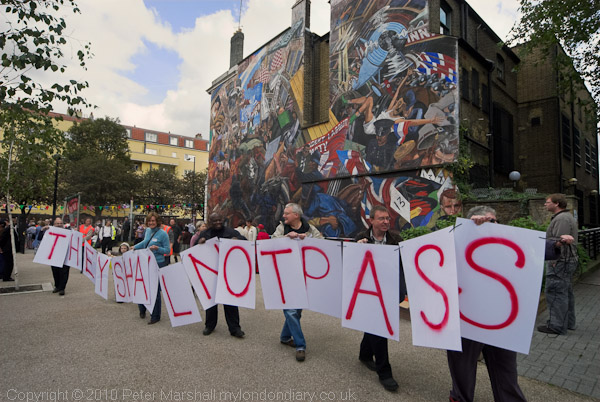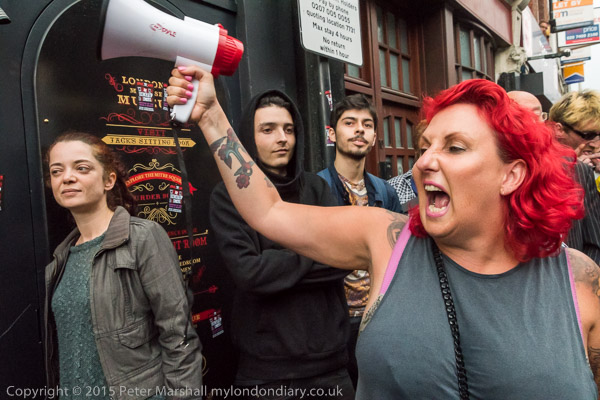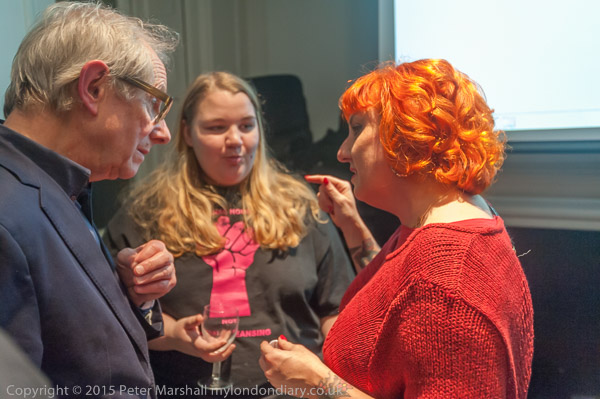
Cable St 70th anniversary, October 2006
I wasn’t at Cable Street in 1936, but was expecting to be there today, 79 years to the day after the ‘battle‘, but yesterday Class War cancelled their planned protest against the Jack the Ripper Museum there. It isn’t really a museum of course, although the owner pretended it would be, getting planning permission to open a museum celebrating the history of women in London’s East End.
That would have made an interesting museum, but would have been unlikely to make the kind of money the owner was obviously after in setting up the tacky tourist attraction that has now opened. Several protests have taken place there, and there is now little doubt what most people in the area think about it – and if anyone still has any doubts about its nature they should read the review by Fern Riddell on Storify or the article based on that in the Independent newspaper.
Fern Riddell is a historian who specialises in the period and in the area, and a consultant on the BBC’s Ripper Street series, so someone whose opinion is of value. Her conclusion: ” it’s not a museum. It’s a poorly executed shock attraction.”
Earlier in their planning, before the change of purpose, the Museum had consulted a friend of mine formerly from the Museum of London who was shocked to hear her name being used to attempt to give the ‘museum’ credibility and made it very clear to the owner that this was entirely unacceptable, getting an undertaking from him not to do so – which he has now broken.
I photographed protests by Class War outside the ‘museum’ on August 5th and 12th, and filed my pictures in the usual way. There was no interest in the protests from the media and none of my pictures were used at the time. Both protests were relatively peaceful, though one small pane of glass was cracked. The protesters held up the traffic on a minor road for some minutes, made a lot of noise, and on the second occasion let off a few flares.

Lisa McKenzie at protest against the Ripper ‘museum’
In the last week, one of my pictures taken at the protest on August 5th has appeared in several newspapers, some of them more than once. The reason is that some of the same people who organised the ‘Ripper’ protests also organised an anti-gentrification street party in Shoreditch a week ago on Saturday night.
Around a thousand people turned up and took part; I didn’t go although I had been asked to, because I’d had a busy day and its quite a trek from where I live. There was music, masks, dressing up and Class War’s banners; a lot of chanting and shouting, flares, arguments with police who tried to stop it – and some fighting with police when they started pushing people off the road.
I wasn’t there, but many others were with cameras and phones and I’ve seen the videos and heard people’s stories. There were two fairly minor incidents in which two shop fronts were attacked. There was a lot of angry shouting, and the glass of an estate agents window was cracked, and slogans daubed on a hipster-run ‘cereal shop’.
There were a few other nasty incidents recorded on video, including a police attack on a young woman which could have been really serious, and there were a few injuries and some arrests. But it is the cereal shop incident that has apparently enraged the newspapers, causing them to throw as much mud as they can at anyone connected with Class War, whether or not they were around at the time. Someone even invented a story about the protesters – many of whom also campaign for animal rights – ripping a dog apart with their bare hands for the press. Though there were no real witnesses.
The woman with a megaphone in my picture became one of their chief targets, with some articles that can only be described as vitriolic, although she had left the protest before any trouble occurred. It’s a picture I like because it shows her as a strong and determined woman, and one which I think celebrates her and the working class culture from which she comes.
She left school shortly before she was 16, taking time off school with other women from miner’s families to support their striking men, worked 10 years in a stocking factory, then in shops etc, living in the notorious St Ann’s district of Nottingham. She became a single mother and at 30 took an Access course, going on from there to study at Nottingham University for a first degree and then her Ph.D.
Back in 1970 I bought a book, a Penguin Special, ‘Poverty: The Forgeotten Englishmen‘ by Ken Coates and Richard Silburn, based on their studies in St Ann’s (though the cover photograph by Roger Mayne was I think from North Kensington.) It was this book which inspired Lisa McKenzie to study the area she lived in and knew – and which ended up in her doctorate and the book ‘Getting By‘ that came out earlier this year.*

Ken Loach, Jasmine Stone and Lisa McKenzie, author of ‘Getting By’ talk at the book launch
Hers is really a great story of success, a positive story that my picture I think celebrates, but in the media she is portrayed as the devil, an ‘academic‘, someone who obviously doesn’t know anything about the lives of ordinary people. They suggest she is wealthy and privileged and using the lives of the poor for her advantage, but she is in a job that almost certainly pays less than the average wage and her work is all about supporting working class people and their values.
Once you put work into an agency you lose control over it. I’m sure there are uses for which my agency would not supply pictures, publications they would not supply images to, but these were articles in the mainstream press. Companies which almost any agencies would supply images to in good faith. You can’t vet articles when you are supplying pictures, and nor should you be able to or have to. We should demand higher journalistic standards from the press.
But perhaps all is not lost. I cling to the hope that many readers – even of the gutter press (and more seems to be aiming for the gutter at the moment) will see the picture for what it is – an affirmative image of a strong and obviously working-class woman protesting against the horror of a ‘shock attraction’ that glorifies ‘nameless violence inflicted on nameless women’. And perhaps there will be many, particularly working-class women who are less scared of the idea of a strong working-class woman than newspaper editors.
* Any journalist writing about her who had done even a few seconds of research would have found this information about her in an article in The Guardian: The estate we’re in: how working class people became the ‘problem’. It comes up as the second item when I search for her on Google.